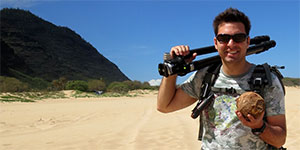A camera is a tool and nothing more; in a sense, one can say a camera is a means to an end in that it alone cannot create art. Art, or more specifically, fine art, requires a person with a vision that has the capacity and knowledge of the tools and techniques available in order to see through and complete that vision. This creation process is an amalgamation of techniques, which cannot exist on their own; each technique requires a certain list of technical prerequisites that must be met in order to maximize emotional feeling and visceral impact.
My final vision all starts by getting acquainted with my location – this means I view my scene from varying angles and make several compositions in my head before I actually pick up a camera. I study the lighting and its qualities, the sounds of the area, and I gather an overall feeling of my surroundings and incorporate that into my end results. For example, I may hear bumble bees buzzing around while they gather nectar from a flower. That action resonates from within my artwork through playful colors, or subtle lighting bursts through clouds that suggest a life force presence.
Naturally, the scene and conditions determine much of the information I can and cannot emphasize – I simply work within these boundaries and express my creativity by building upon available features.
After I have captured my scene, it’s off to the digital darkroom where my vision continues to take shape. I will assess the color palette and make changes using a white balance target, selectively sharpen, merge multiple exposures, focus stack, increase or decrease saturation, and adjust tonal curves and brightness. These techniques allow me to express my feelings as I felt them while capturing the image. Maybe a primary color spoke to me, or the natural field of view was not deep enough to capture in one exposure; these techniques simply put emphasis on the vision I saw at that moment.
I also pay attention to high contrast areas and will remove artifacts that detract from my overall vision – these can be distracting subject highlights, chromatic aberrations, or incomplete textures or tonal variations; this allows me to direct your eye to dominant areas of the artwork in a chronological progression and will also help you successfully unravel its message over time.
Some of my artwork is cropped; this is done to further refine an already strong composition into an image that expresses a dominant feature from a different perspective.
My final vision is complete only when I can view my creation and transcend to the moment the camera shutter clicked. If what I see this instant is able to transport me back in time to experience the emotional connection with my scene, whether it’s the warmth on my face from the hot August sun, inner balance and tranquility from gently flowing water, or the rush of being alive after inhaling brisk winter air, I have met my goal of creating the fine art you see before you.
Thomas M Thurston
Morris Plains, New Jersey
2012
You can learn more about me and where I find my inspiration by reading my bio.

